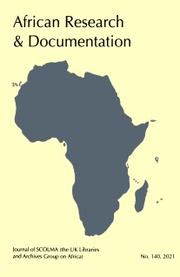No CrossRef data available.
Article contents
The Decline of Indigenous Language in African Literature: A Model of the Yoruba Language
Published online by Cambridge University Press: 25 April 2022
Extract
“African literature has presented a lot of problems especially what is to be considered African literature, in which language it should be written, what it should be about, and who should be considered an African writer“(Ndede, 2016:2). This article discusses the linguistic hegemony of the colonial languages with particular reference to Yoruba. “The Yoruba country lies roughly between latitudes 6° and 9°N and longitudes 2° 30’ and 6° 30’ East. The area spreads across the republics of Benin and Togo. The Yoruba are also found in such places as Sierra Leone, Gambia and across the Atlantic in the Caribbean and South America especially in Brazil” (Atanda, 1996; cited in Salawu, 2004).
According to Arifalo and Ogen, Yoruba people are forty million worldwide and they further assert that the Yoruba ethnic group is one of the biggest in West Africa (Arifalo and Ogen, 2003; cited in Salawu, 2004).
- Type
- Research Article
- Information
- Copyright
- Copyright © International African Institute 2021


